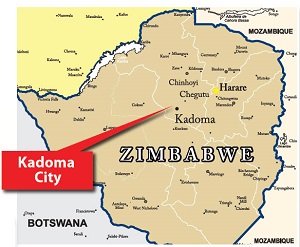Improving Immunization Coverage through Short Message Service (SMS) Reminders in Zimbabwe
Submitted by: Prof Mufuta Tshimanga, Zimbabwe FETP Director

Map of Kadoma City, Zimbabwe. Kadoma City population is 92,000 (CSO 2012); One hospital and 5clinics; Expected deliveries per year – 2469..
Despite significant increases in routine immunization coverage worldwide since the launch of the ExpandedProgram on Immunization (EPI) in 1974, non-attendance for immunization appointments remains a global challenge. Low immunization coverage persists in sub-Saharan Africa due to failure by parents or caregivers to bring their children for immunization. The WHO estimated that in 2011, only 71% of children in sub-Saharan Africa completed the full course of three Diphtheria, Pertussis and Tetanus (3DPT) vaccinations in their first year of life. As a result, there is an urgent need to develop new and innovative strategies to fully immunize more children, especially those in hard-to-reach and vulnerable areas. The adoption of short message services reminders (SMS) has been shown to enhance attendance in some medical settings.
To investigate the effectiveness of SMS reminders for immunization in Kadoma City, a randomized controlled study was conducted at Kadoma City Clinics, Zimbabwe, in 2013 by Mr. Bangure Donewell, a recent graduate of the Zimbabwe Field Epidemiology Training Program (FETP). Through this study, he assessed the effectiveness of SMS reminders on improving childhood immunization coverage. He also determined the cost associated with the use of SMS reminders on childhood immunization in Kadoma, Zimbabwe. Women who were residents of Kadoma and delivered children at Kadoma City Clinics were recruited. In the intervention group, three SMS reminders were sent to mothers 7, 3 and 1 day before their children were scheduled for their 6, 10 and 14 week immunization visit. In the non-intervention group no message reminders were sent. All women in both groups received routine health education on the recommended immunization schedule for their children and were issued with immunization cards post-delivery.
A total of 304 participants were recruited (152 for inclusion in the intervention group and 152 for the non-intervention group). At 6 weeks, immunization coverage was 97% for the intervention group and 82% for non-intervention. At 10 weeks, immunization coverage was 96% for the intervention group and 80% for non-intervention group. At 14 weeks it was 95% for intervention and 75% for non-intervention group. Those who delayed receiving immunization at 14 weeks were 82% for the intervention and 8% for non-intervention group. Median delay for intervention was 0 days and 10 days for the non-intervention group. The results of the study showed that the immunization targets in Kadoma City, Zimbabwe can be achieved if SMS reminders are used. In addition, the associated costs for SMS per child for 18 months is very low — U.S $0.99. The SMS study results were shared with the Kadoma City Health Director, Mr Daniel Chirundu. In response, he has started mobilizing resources to ensure that the SMS intervention is implemented at all health facilities in Kadoma that are offering routine childhood immunization.
On April 30th 2014, Mr. Bangure presented this study during International Night at the 63rd Annual Epidemic Intelligence Service Conference in Atlanta, Georgia, USA. The title of his paper was “Effectiveness of Short Message Service Reminders on Childhood Immunization Program in Kadoma, Zimbabwe, 2013 – A Randomized Controlled Trial”. For his efforts, Mr. Bangure received the 2014 William H. Foege Award for Most Outstanding Public Health Scientific Oral Presentation.
For further information, please contact: Mr.Bangure at bangured@yahoo.com.